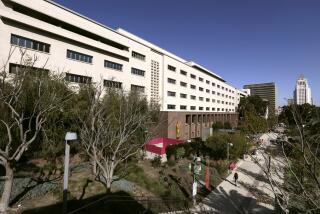History, Patriotism Make Skunk Works Worth Saving
- Share via
The historic Burbank birthplace of America’s most significant military and strategic intelligence airplanes--the Stealth fighter, U-2 spy plane and SR-71 Blackbird--is about to be destroyed.
Despite evidence that local air passenger demand and airport revenue have declined in recent months, the Burbank-Glendale-Pasadena Airport Authority and the Federal Aviation Administration are pressing forward to expand the Burbank Airport. In its unjustified haste, the authority, with the FAA’s blessing, is prepared to demolish the two remaining historic Skunk Works buildings not far from the airport runways. And what’s more, authority commissioners have chosen to disregard the recommendations of a federal historic preservation agency and to misrepresent expert findings about the B-6 site’s historic authenticity.
At risk are the old Lockheed Constitution Hangar (building 309 / 310) in Burbank and the Skunk Works flight-test operations building 360 on the Los Angeles part of Burbank Airport.
Lockheed Martin began demolishing related historic structures in November. This June, the authority acquired 130 acres by condemning the B-6 site, which housed the major Skunk Works complex. Unless stopped now by public action, the Airport Authority and FAA will destroy these buildings first and then talk about the matter later, just as they did with the historic Earhart / Hughes Hangar in 1994.
Why preserve these two buildings? First, because they are an authentic part of America’s and our community’s aeronautical, industrial, geopolitical and economic history; and second, because they can be revived to become useful components of California’s economic and social fabric.
The historic authenticity of the buildings is beyond dispute, narrated and validated in uncounted formal and informal documents and published works. Lockheed-Martin itself emphasized the historical importance of the Skunk Works when it told a U.S. District Court in April 1997: “In 1943, the Government enlisted Lockheed-Martin to produce a top-secret jet airplane to further the war effort. With the production of the P-80 Shooting star, the now famous ‘Skunk Works’ was born. The Skunk Works, housed at portions of Plants B-1, B-6 and C-1 from 1943 through 1991, produced top-secret aircraft for the Government such as the U-2 Spy plane and the F-117 Stealth Fighter.”
Opposing the buildings’ needless destruction are the Advisory Council on Historic Preservation in Washington, D.C., and other patriotic Americans.
There is ample precedent for the buildings’ innovative restoration for public and commercial uses. The buildings and adjacent land would happily accommodate an aviation memorial park where families could picnic, see the SR-71 Blackbird and other historic planes created in Burbank, and watch planes land and take off from the nearby airport. One possible use is an aero museum featuring Lockheed’s great planes and exhibits honoring the men and women who, through World War II, the Korean War and the Cold War, designed, built, flew or maintained the great aircraft that won the peace and preserved national security. Innovative commercial uses (such as a DreamWorks-type project) are possible too.
But it is unconscionable that these monumental historic buildings, once a nest for the blackest of the “black world” (supersecret) projects, should be hastily trashed for nothing grander than bureaucratic callousness and short-term profit that leaves Burbank.
More to Read
Sign up for Essential California
The most important California stories and recommendations in your inbox every morning.
You may occasionally receive promotional content from the Los Angeles Times.













